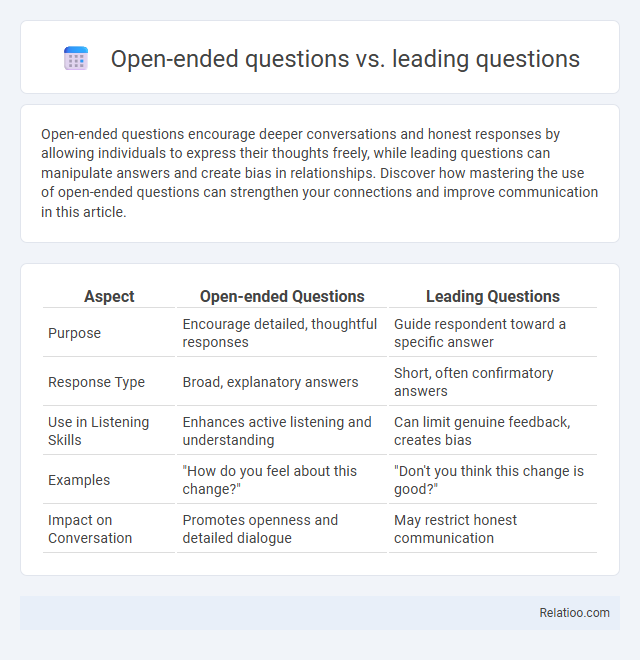Open-ended questions encourage deeper conversations and honest responses by allowing individuals to express their thoughts freely, while leading questions can manipulate answers and create bias in relationships. Discover how mastering the use of open-ended questions can strengthen your connections and improve communication in this article.
Table of Comparison
| Aspect | Open-ended Questions | Leading Questions |
|---|---|---|
| Purpose | Encourage detailed, thoughtful responses | Guide respondent toward a specific answer |
| Response Type | Broad, explanatory answers | Short, often confirmatory answers |
| Use in Listening Skills | Enhances active listening and understanding | Can limit genuine feedback, creates bias |
| Examples | "How do you feel about this change?" | "Don't you think this change is good?" |
| Impact on Conversation | Promotes openness and detailed dialogue | May restrict honest communication |
Understanding Open-ended Questions
Open-ended questions encourage detailed responses, promoting deeper understanding and richer conversations by allowing You to express thoughts freely. Unlike leading questions, which suggest a specific answer and may bias responses, open-ended questions invite unbiased, expansive answers. Mastering open-ended questions enhances communication skills and aids in gathering comprehensive information.
Defining Leading Questions
Leading questions subtly prompt your response by implying a preferred answer, often steering the conversation in a specific direction. Unlike open-ended questions that encourage expansive and unbiased replies, leading questions contain presuppositions or suggestions embedded within their phrasing. Understanding this distinction is crucial for effective communication, research, and legal proceedings where unbiased information gathering is essential.
Key Differences Between Open-ended and Leading Questions
Open-ended questions encourage detailed, unrestricted responses that provide rich qualitative data, whereas leading questions subtly guide the respondent toward a predetermined answer, potentially biasing the results. Key differences include the intent and structure; open-ended questions begin with words like "how," "what," or "why," promoting exploration, while leading questions contain suggestive language that influences opinions. Understanding these distinctions is crucial in survey design and qualitative research to ensure data validity and minimize response bias.
Advantages of Open-ended Questions
Open-ended questions encourage detailed responses, fostering deeper insight and richer conversations that reveal your customers' true thoughts and feelings. Unlike leading questions, which can bias answers or limit perspective, open-ended prompts empower respondents to share authentic experiences and ideas. This approach enhances understanding, enabling better decision-making and stronger connections based on genuine feedback.
Drawbacks of Leading Questions
Leading questions often bias responses by suggesting a particular answer, compromising the reliability of the data collected. Your ability to gather authentic insights diminishes because respondents may feel pressured to conform to implied assumptions. This drawback makes leading questions less effective in qualitative research compared to open-ended questions, which encourage genuine, detailed feedback.
Impact on Data Quality and Accuracy
Open-ended questions enhance data quality by allowing respondents to provide detailed, nuanced answers that reveal true opinions and experiences, improving the accuracy of qualitative insights. Leading questions can bias responses, distorting data accuracy by nudging respondents toward predetermined answers and compromising the integrity of the results. Your choice between open-ended and leading questions significantly impacts the reliability and validity of collected data, influencing subsequent analysis and decision-making.
When to Use Open-ended Questions
Open-ended questions are essential for eliciting detailed and thoughtful responses, making them ideal during interviews, surveys, and counseling to explore opinions, feelings, or experiences deeply. Unlike leading questions that suggest a particular answer, open-ended questions encourage genuine, unbiased insights, fostering richer dialogue and better understanding. Use open-ended questions when the goal is to gather comprehensive information, promote critical thinking, or build rapport through open communication.
Risks of Bias with Leading Questions
Leading questions often introduce bias by suggesting a particular answer, which can distort Your responses and compromise data integrity. Open-ended questions reduce this risk by allowing free, unbiased expression, fostering authentic insights. Choosing open-ended formats helps ensure more accurate, reliable information without the influence of presupposed answers common in leading questions.
Strategies for Crafting Effective Questions
Crafting effective questions involves understanding the distinct impact of open-ended, leading, and closed questions on responses. Open-ended questions encourage detailed, thoughtful answers by allowing You to explore perspectives without bias, while leading questions steer responses toward a predefined answer, potentially limiting authenticity. Employing strategic use of open-ended questions promotes genuine dialogue and richer information, essential for research, interviews, and communication success.
Practical Examples and Comparisons
Open-ended questions encourage detailed responses by inviting explanation, such as "What are your thoughts on improving team communication?" Leading questions suggest a particular answer, for example, "Don't you think our current process needs improvement?" Comparing these types, open-ended questions foster unbiased dialogue and deeper insights, while leading questions can bias responses and limit genuine feedback. Practical application of open-ended questions is vital in interviews and research to gather comprehensive data, whereas leading questions may be useful in sales or persuasion but risk skewing information accuracy.

Infographic: Open-ended questions vs Leading questions
 relatioo.com
relatioo.com